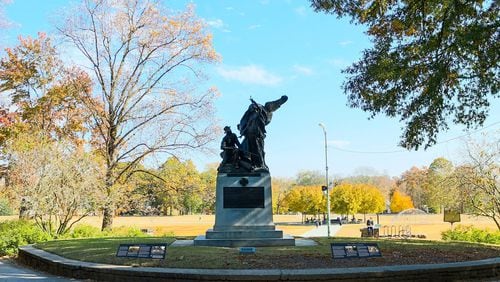Atlanta became the first city in the country to install contextual markers around its Confederate monuments a month ago, but the local branch of the NAACP says the explanations on the signs aren’t good enough.
In a Tuesday letter to the Atlanta City Council, Atlanta branch president Richard Rose said the markers don’t “counter the notion of white supremacy.” On Wednesday, Rose went further, accusing members of a council committee of being “complicit on compromising on racism.”
“It’s such a profound disappointment,” Rose said of the language on the markers. “It doesn’t give the story of why these monuments were built and the effect they have to this day.”
The markers were one of several suggestions by a blue-ribbon panel created in 2107 by then-mayor Kasim Reed to deal with controversy surrounding the city’s Confederate monuments. Some have pushed for their removal, but a state law prohibits that. Contextualizing markers — which add information about how African-Americans were disenfranchised before and after the Civil War — was seen by the panel, and later the council committee, as a way to address the monuments’ contentious history.
That context has been added to the “Peace Monument” in Piedmont Park and the “Peachtree Battle” marker in Buckhead. Oakland Cemetery will install markers around the “Lion of Atlanta” and the “Confederate Obelisk” in the coming weeks.
Council Member Carla Smith, who led the council committee, defended the language on the markers. They discuss white supremacy, Jim Crow laws, segregation and their legacy.
“We didn’t try to sweep it under the rug,” Smith said. “Hopefully, 100 years from now, somebody will say, ‘They may not have been perfect, but they tried under the state law they were living under.’”
Specifically, Rose said he was offended by the mention of educator and Tuskegee Institute (University) founder Booker T. Washington on the Piedmont Park “Peace Monument” markers.
Washington’s legacy is complicated. For generations, he was seen by some as a positive, transformative figure in African-American history, for his founding of Tuskegee. His legacy also has come under harsh criticism and seen by some scholars as accommodationist.
Atlanta History Center Vice President Calinda Lee, who authored the Piedmont Park signs, defended the markers in a letter to staff. She said she included Washington because he gave his famous 1895 speech in the park during the Cotton State Exposition. In the speech, Washington urged African-Americans not to seek social integration with white people but to pursue economic stability.
On the same contextual marker, Lee also described the arguments of Washington’s biggest, African-American critic, W.E.B. Du Bois. Du Bois — who taught at Atlanta University, now called Clark Atlanta University — said his colleague was accommodating the old racial hierarchy. Du Bois advocated for an aggressive civil and social rights agenda.
“In no way are the contextualization markers intended to affirm calls for segregated society, or to suggest that anyone should ‘encourage the acceptance of white supremacy,’” Lee wrote. “The markers are also, however, not intended to be rhetorical spaces but, rather, to provide information in as clear and unbiased a manner as possible so that readers can discern for themselves the intentions of those who installed the monuments and the historic people and events that they depict.”
Rose didn’t offer suggestions on how the markers should be changed.
Sheffield Hale, president and CEO of the history center, said Rose’s criticisms are actually part of a conversation the markers are meant to promote. The markers can be subject to change or addition as time goes on, Hale said.
“We ought to be discussing the history, and that’s what they are there for,” Hale said.
About the Author







